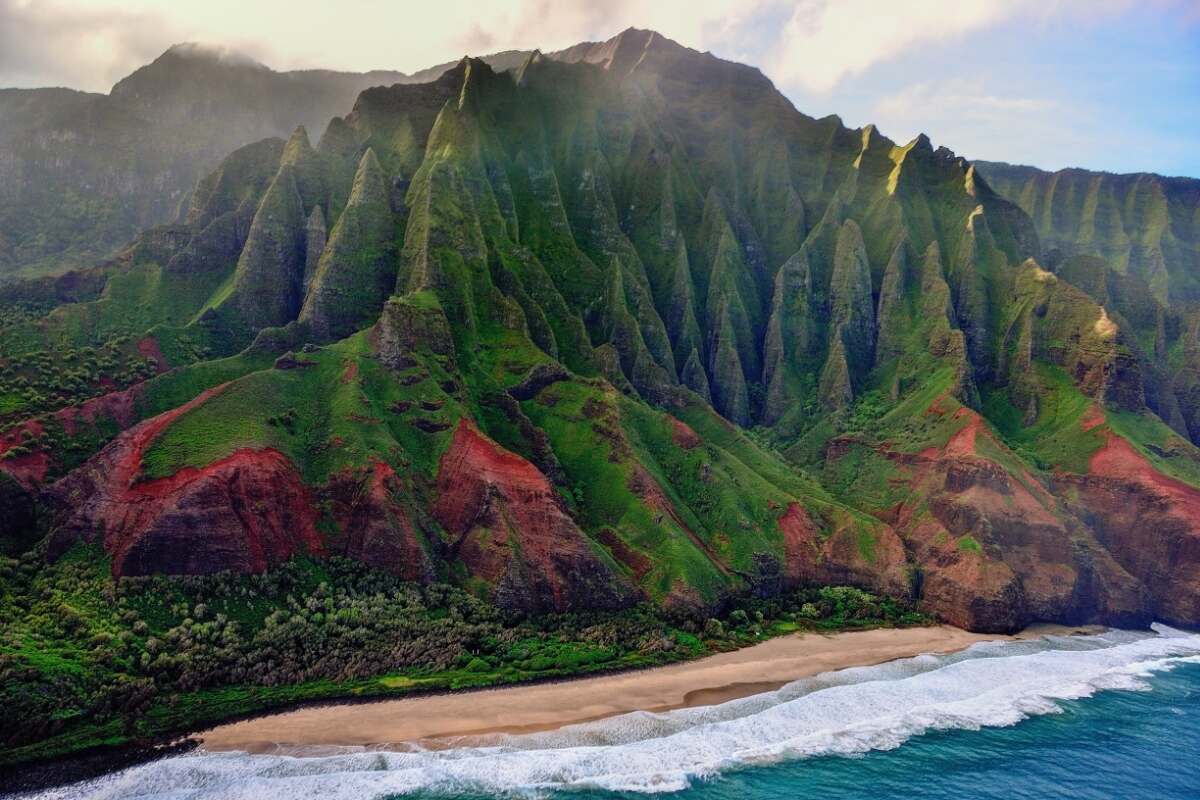
The best low-maintenance ground covers for Hawaii’s climate are tropical vines, shrubs, and clumping sedges. Ilima papa, Pauohiiaka, akia, nanea, and golden glory are just a few to mention.
This article covers the top 14 options for your garden in Maui, Kauai, Lanai, Oahu, Nihau, Kaholawe, or Malaki. Read on to learn which ones grow best on the coast and which inland, what ground covers accept brackish water, how they deal with shade, and which plants are edible or medicinal.
- 14 Best Low-Maintenance Ground Covers for Hawaii
- 1. Ilima Papa (Sida fallax)
- 2. Pauohiiaka (Jacquemontia ovalifolia ssp. sandwicensis)
- 3. Akia (Wikstroemia uva-ursi)
- 4. Pohinahina (Vitex rotundifolia)
- 5. Ukiuki (Dianella sandwicensis)
- 6. Hinahina (Heliotropium anomalum var. argenteum)
- 7. Iliee (Plumbago zeylanica)
- 8. Nanea (Vigna marina)
- 9. Aeae (Bacopa monnieri)
- 10. Akulikuli (Sesuvium portulacastrum)
- 11. Golden Glory (Arachis pintoi)
- 12. Kupukupu (Nephrolepis cordifolia)
- 13. Red Ivy (Hemigraphis alternata)
- 14. Mondo Grass (Ophiopogon japonicus)
- Pros and Cons of Choosing Ground Covers
- How to Choose the Right Ground Cover for Your Hawaii Yard
- Planting Ground Covers in Hawaii in Five Simple Steps
- Ground Cover Maintenance in Hawaii
- FAQ
14 Best Low-Maintenance Ground Covers for Hawaii
Whether you’re looking for a low-maintenance lawn alternative or a creeping plant to fill space in your garden, these ground covers are your best bet for growing in Hawaii.
1. Ilima Papa (Sida fallax)
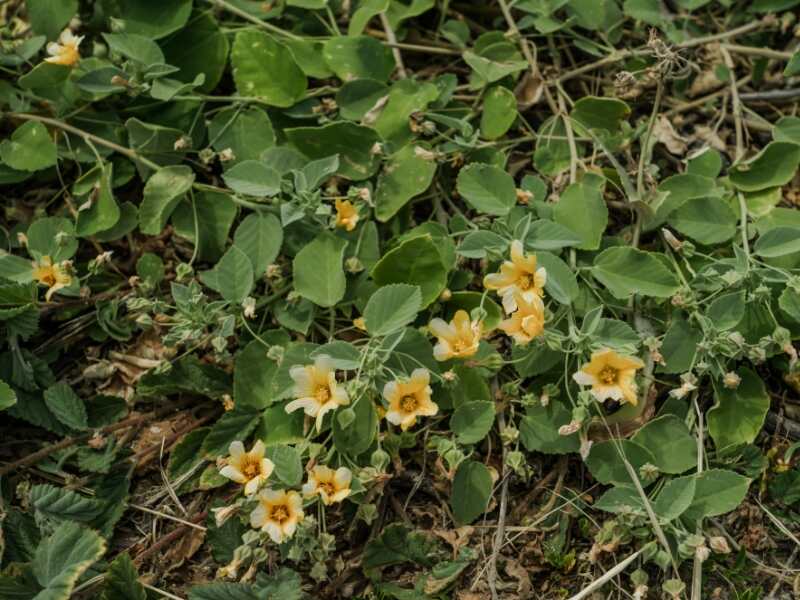
Ilima papa is a famous star since it bears the island flower of Oahu – a hibiscus-shaped beauty, in bright yellow to orange shades, that shines in the mass of green leaves. The petals are edible and often used as exotic salad decorations.
A shrub with a spreading growth habit, ilima papa has unique resilience to harsh conditions. Strong winds, salt spray, drought, intense heat – none of it keeps this hardy ground cover from thriving.
- Other common names: Ilima Ku Kahakai, ground cover ilima.
- Size at maturity: 2 to 4 inches tall and 3 to 4 feet wide.
- Light requirements: Full sun to partial shade.
- Soil type: Plant ilima papa in well-drained, non-clay soil.
- Tolerant of: Salt spray, wind, and drought.
- Maintenance:
— Avoid overwatering. Irrigate by soaking the soil and letting it dry completely before applying water again.
— Trim the shrubs to encourage branching and keep the plants confined to the growing area.
2. Pauohiiaka (Jacquemontia ovalifolia ssp. sandwicensis)
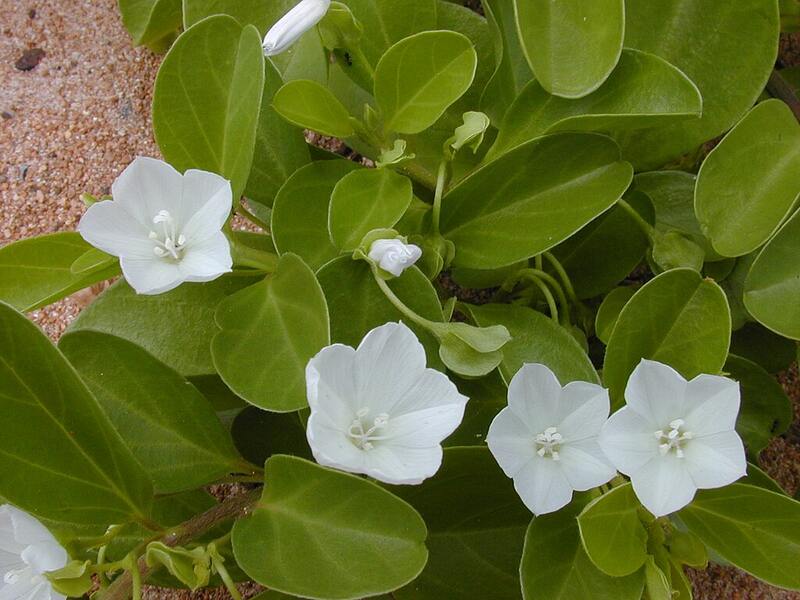
Pauohiiaka hugs the soil in dense mats of small, thick, light-green leaves. From December to July, it explodes in bunches of white to pale blue flowers. Where its stem nodes touch the ground, roots grow. They form a dense, deep network that keeps soil in place, fighting erosion. It also gives the plant unbelievable wind resistance.
This crawling vine is a coastal native that tolerates brackish water and salt spray. It can also withstand drought and heat, making an attractive ground cover to replace seashore paspalum and Zoysiagrass.
- Other common names: Kakuaohi’iaka, Kaupo’o, Pā’ūohi’iaka.
- Size at maturity: 2 to 4 inches tall and 3 to 5 feet wide.
- Light requirements: Full sun to part shade.
- Soil type: It thrives in sandy, coral, and cinder soil with good drainage.
- Tolerant of: Wind, salt spray, irrigation with brackish water, and mild droughts.
- Maintenance:
— Allow to dry between waterings.
— Prune growing points to encourage branching and keep the plants confined to their growing area.
Where to buy reliable pruning shears:
3. Akia (Wikstroemia uva-ursi)
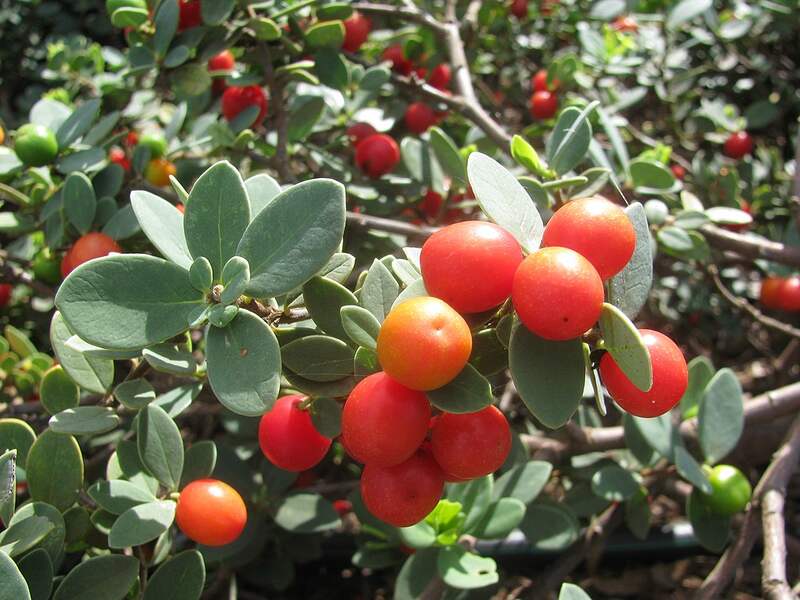
Akia is a native ground cover that thrives in the windy coastal areas of Hawaii. It grows on dry ridges, open hillsides, and across ‘a’a lava areas on Kauai, Oahu, Molokai, and Maui.
This sprawling shrub fits best along walkways, around patios, and near home walls. It’s fragrant and good-looking, with yellow, gray, or reddish-brown branches. Akia flowers bloom light green to bright yellow, filling the evening air with an exotic musk-like aroma.
Consider it for the dry areas in your yard and if you plan to xeriscape your garden. Akia comes with low water requirements and a high drought tolerance.
- Other common names: Kauhi, Molokai osmanthus, fish poison plant, hillside false ʻōhelo.
- Size at maturity: 6 to 36 inches tall and 2 to 5 feet wide.
- Light requirements: Full sun.
- Tolerant of: Salt spray, wind, and drought.
- Soil type: It grows on various soil but prefers well-drained.
- Maintenance:
— Water established Akia once or twice a month in dry periods.
— Trim only to shape or encourage branching.
4. Pohinahina (Vitex rotundifolia)
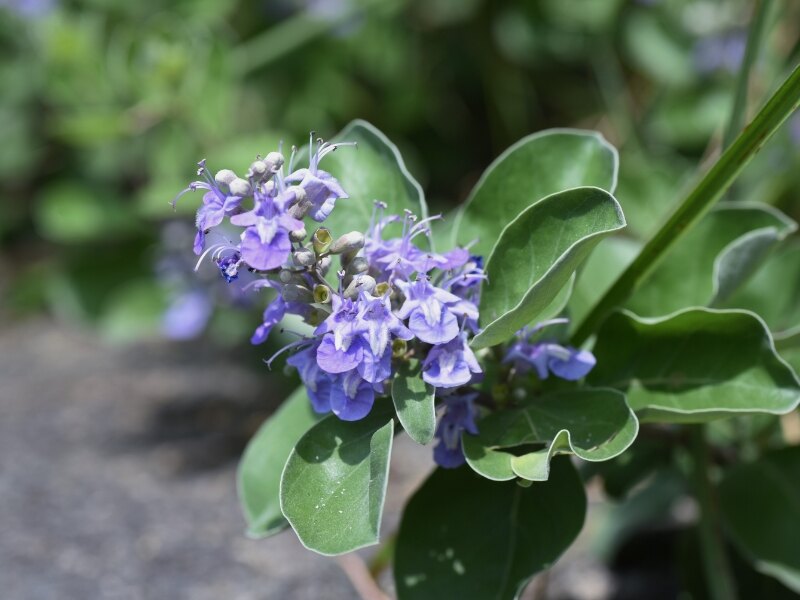
Pohinahina is a fragrant shrub that can bring the forest’s fresh scent into your backyard. It doesn’t look like a fir tree, but its gray-green to silver leaves carry that Christmasy scent mixed with notes of sage and mint.
You can grow it as an accent plant, ground cover, or hedge. It thrives in containers and hanging baskets on the porch or indoors. When it blooms, small, light blue to purple flowers fill the branches.
- Other common names: Kolokolo kahakai, Hinahina kolo, Mawanawana, Polinalina, Beach vitex.
- Size at maturity: 2 to 5 feet tall and 6 to 8 feet wide, depending on variety.
- Light requirements: Full sun. It becomes leggy in the shade.
- Soil type: It grows in well-drained clay, sand, or cinder soils.
- Tolerant of: Wind, salt spray, and drought.
- Maintenance:
— Prune regularly to keep its shape and to encourage new growth.
— Once established, water only during prolonged drought.
5. Ukiuki (Dianella sandwicensis)
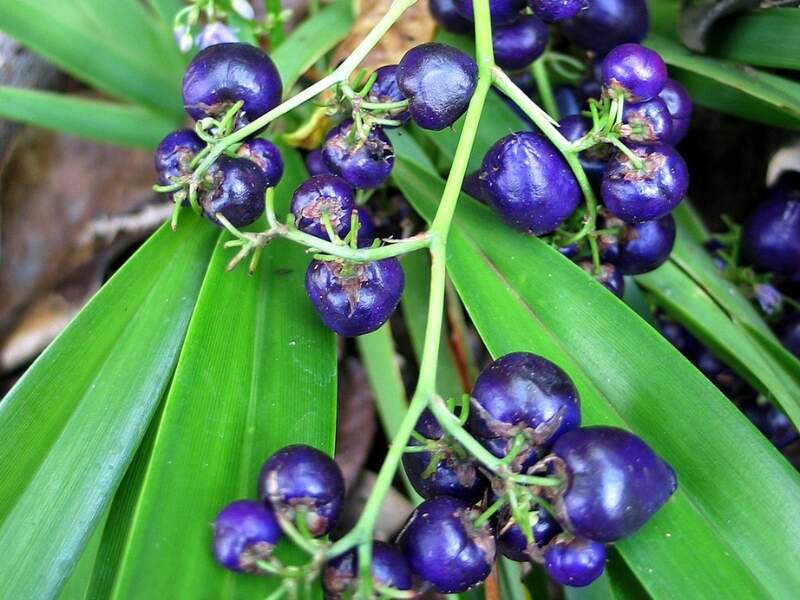
Ukiuki grows naturally across the Hawaiian islands in dry shrublands and forests. Year-round, it blooms tiny, white to blue flowers that turn into blue berry-like fruits. But the foliage is its top attraction. It has iris-like, long, light green leaves forming rich, ruffled clumps – elegant and wild at the same time.
Landscapers often use it as an understory for ground covers, shrubs, and trees. You can also plant it along walkways or make it an accent plant in a yard with a classic turfgrass lawn.
- Other common names: ‘Uki‘uki, Uki, Hawaiian Dianella, and Hawaiian lily.
- Size at maturity: 1 to 2.5 feet tall and 3 to 5 feet wide.
- Light requirements: Full sun to part shade.
- Tolerant of: Standing water, drought, salt spray, and wind.
- Soil type: It can grow in various soils but requires good drainage.
- Maintenance:
— Divide the clumps periodically.
— Remove brown leaves and spent flowers to keep a neat look in your garden.
— Water once or twice a week, depending on rainfall.
6. Hinahina (Heliotropium anomalum var. argenteum)
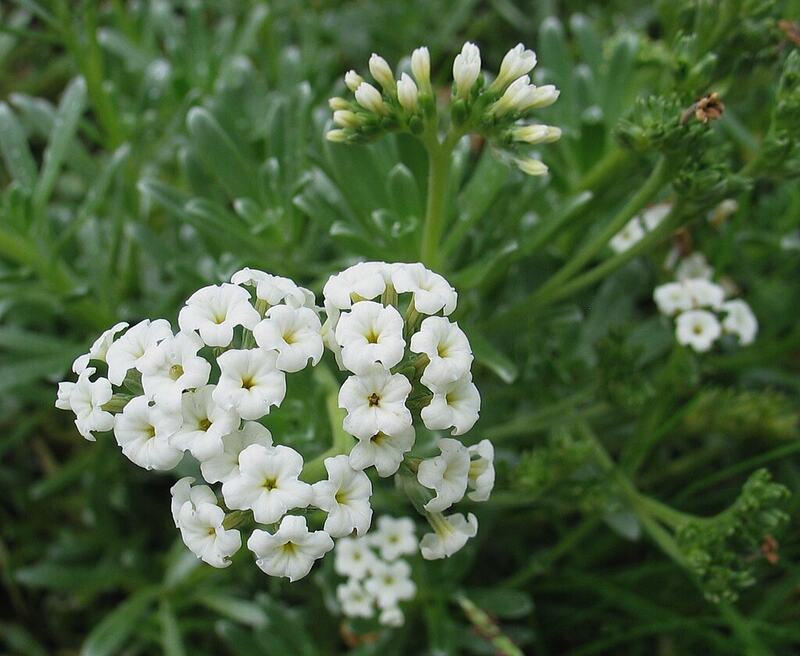
A beautiful, succulent groundcover, hinahina looks great in xeriscape designs and rock gardens. It has light green, grey, or silvery leaves that grow in rosettes and change their shade with the weather. Plant it on a black cinder or rocky topsoil. It’s where its huddling leaves contrast their colors the best.
Hinahina crawls on rocks and mounds, making an ideal option for less leveled yards. Could you enjoy it in your coastal garden? Or in a dryer yard with a leeward location? Yes, and yes! It’s a low-maintenance native with excellent salt and drought tolerance, perfect for yards in Paia, Lahaina, or Kailua.
- Other common names: Hinahina ku kahakai, Nohonohopuuone, Pohinahina, Polynesian heliotrope, and Pacific heliotrope.
- Size at maturity: 2 to 6 inches tall and 2 to 4 feet wide.
- Light requirements: Full sun. It thrives in south or west-facing gardens.
- Soil type: Hinahina thrives in sandy soil with good drainage. If you plant it in pots, use a soil mix with crushed coral, cinder, and sand.
- Tolerant of: Wind, salt spray, brackish water, heat, and drought.
- Maintenance:
— Hinahina benefits from occasional drenching with seawater (do this only if you have salt-tolerant plants around it or grow it in pots).
— Water only when the plant shows signs of drought.
7. Iliee (Plumbago zeylanica)
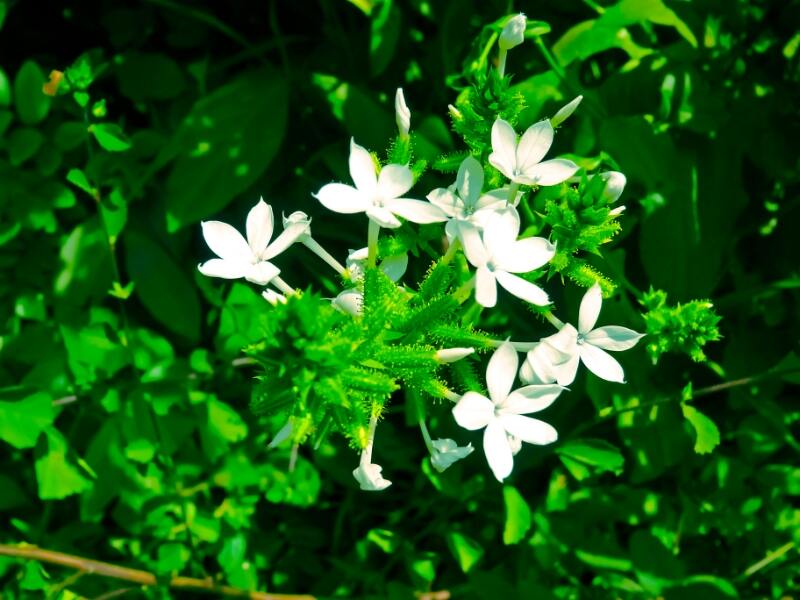
Iliee is native to the arid dunes and dry forests across the Hawaiian islands. Its deep, dense roots stabilize the soil, making it a drought-tolerant, wind-proof, robust ground cover. Above the ground, iliee spreads thin, soft green leaves in airy tufts. This one is a bloomer. Its green halo is covered in showy, star-shaped white flowers you’ll enjoy year-round.
- Other common names: Hiliee, Ilieo, Ilihee, Lauhihi, white leadwort, and wild leadwort.
- Size at maturity: 1 to 3 feet tall and 3 to 15 feet wide.
- Light requirements: Full sun to part shade. It flowers less in the shadier areas.
- Soil type: Prefers well-drained sand, cinder, and organic soils.
- Tolerant of: High heat, drought, and wind.
- Maintenance:
— Prune periodically to keep it in its vegetation space and promote branching.
— It looks best with regular irrigation during the summer but tolerates moderate drought.
8. Nanea (Vigna marina)
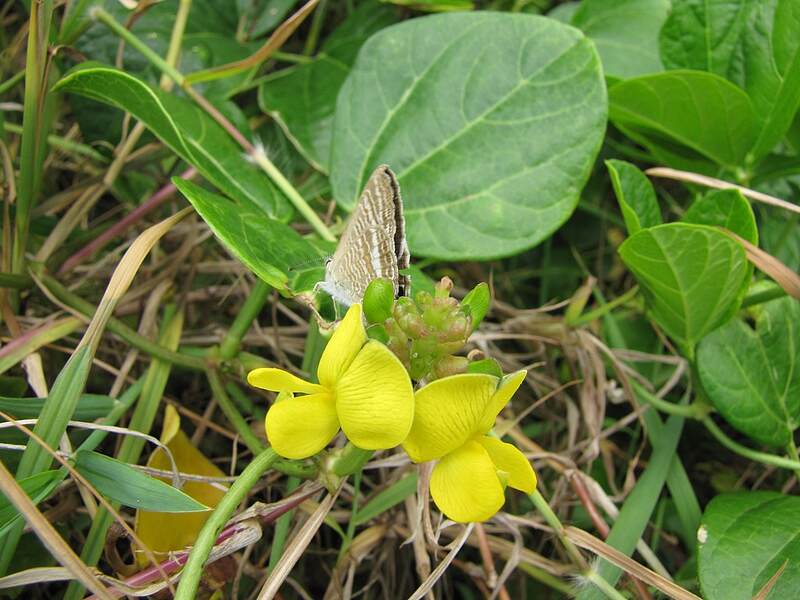
Nanea is a low-growing vine perfect for beachfront properties. It thrives in well-drained soil, tolerates salt spray, and grows best in sunny areas.
Though it often covers the ground in diamond-like leaves, nanea can climb on trellises and fences. Grown on a vertical structure, it forms dense green natural walls. You can use it for privacy or to enhance the look of your patio and home walls.
Pea-like bright yellow flowers add to its charm, though some don’t enjoy the peas that follow them as fruit.
- Other common names: Lemuomakili, Mohihihi, Nenea, Okolemakili, Puhili, Wahine omao, Beach pea, Notched cowpea
- Size at maturity: 6 to 8 inches tall and 5 to 15 feet wide.
- Light requirements: Full sun to partial shade.
- Soil type: Grows in well-drained, sandy, cinder, coral, or organic soils.
- Tolerant of: Wind, salt, heat, and drought.
- Maintenance:
— Irrigate weekly during dry weather, but allow the soil to dry between two sessions.
— A fast-growing, resourceful vine, nanea needs pruning periodically to keep into its own space.
Where to buy beautiful trellises for nanea to climb:
9. Aeae (Bacopa monnieri)
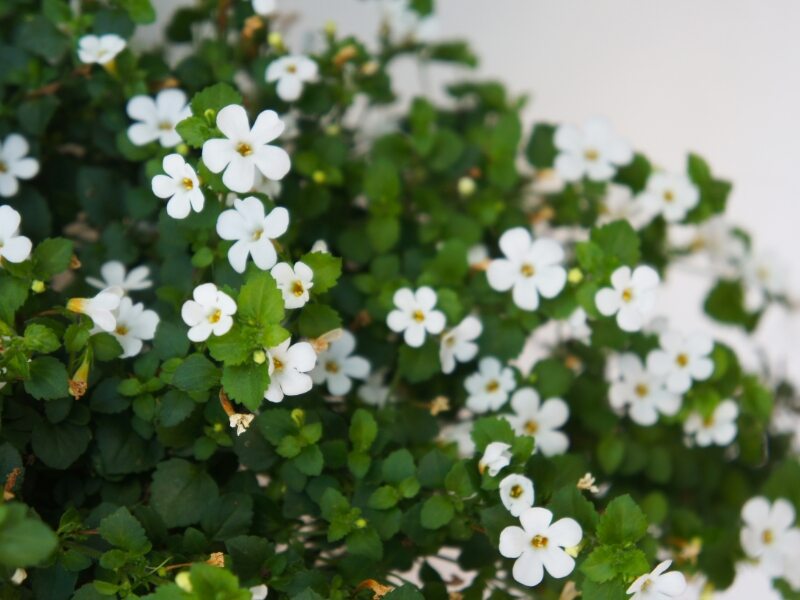
With a garden on the windward side of the islands, you need plants that do well in wet areas. Aeae is the perfect low-maintenance ground cover to use. It also tolerates salt spray and irrigation with brackish water.
Aeae spreads its vines across the soil in clumps of delicate, fleshy, tear-like leaves. When it blooms, tiny white to pale blue flowers open and attract native pollinators. Aeae also shelters invertebrates that feed the native waterfowl – a good reason to add it to wildlife habitats.
- Other common names are: Baby tears, dwarf bacopa, and water hyssop.
- Size at maturity: 2 to 4 inches tall and 1 to 4 feet wide.
- Light requirements: It grows faster in full sun but tolerates shade.
- Soil type: You can plant in clay, sand, cinder, organic, and coral soils, moist to wet. It can grow directly in fresh or slightly brackish water in a garden pond or stream.
- Tolerant of: Brackish water, wet soils, salt spray, and wind. It has low resilience to drought.
- Maintenance:
— Keep it constantly moist or wet.
— Trim to shape it and keep it in its designated area. It can become weedy.
— Tolerates mowing and string trimming much like turfgrasses.
— It’s sensitive to iron deficiency. Treat with chelated iron if leaves turn yellow or white.
Where to buy chelated iron for your garden:
10. Akulikuli (Sesuvium portulacastrum)
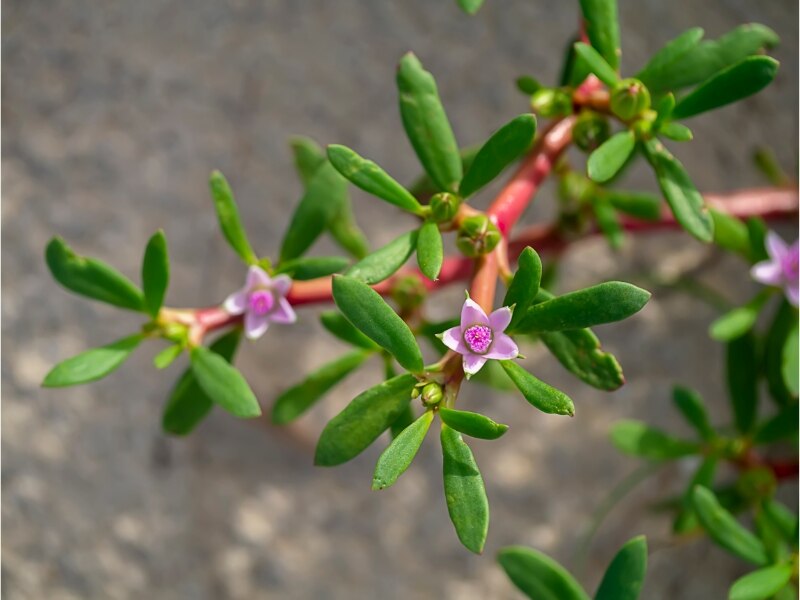
Akulikuli is a lovely addition to windy, sandy beach properties, ponds, and water gardens. Native to Hawaii’s wetlands, it is one of the most salt-tolerant ground covers you can choose. It’s also a low-maintenance plant with good traffic tolerance.
Akulikuli grows thick stems and light green to tinged red succulent leaves. Both plant parts are edible, raw or cooked, and taste salty. Its small purple and pink flowers brighten the landscape and make it a valuable addition to pollinator gardens.
- Other common names: Sea purslane, Seaside purslane, Shoreline sea-purslane.
- Size at maturity: 2 to 5 inches tall and 1 to 4 feet wide.
- Light requirements: It thrives in full sun but tolerates some shade.
- Soil type: Grows in dry, moist, or wet soil with clay, sandy, organic, cinder, or coral texture.
- Tolerant of: Tolerant of wind, heat, salt, drought, foot traffic, soaked soil, and brackish water.
- Maintenance:
— Requires watering only during prolonged drought.
— Prune to keep it in its area.
11. Golden Glory (Arachis pintoi)
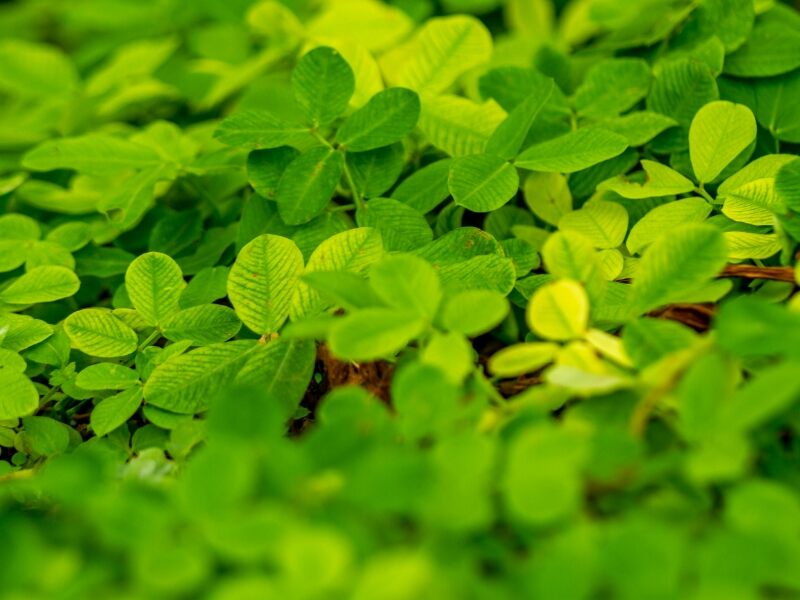
Golden glory is the most common variety of Arachis pintoi in Hawaii. It’s a perennial low-growing legume with deep roots used in horticulture as living mulch. Highly valued in Hawaii’s gardens and orchards, it keeps the weeds at bay and fixes nitrogen in the soil.
It is also a valued ground cover in residential landscaping. A fast grower, it spreads a dense carpet across the yard in less than six months from seed germination. It has dark green leaves and blooms small, pea-like, vibrant yellow flowers.
- Other common names: Pohuehue, pintoi peanut, and Amarillo peanut.
- Size at maturity: 8 inches tall.
- Light requirements: Light shade.
- Soil type:
— Golden glory thrives in well-drained sandy, sandy loam, and clay soils.
— It withstands poor soils and temporary flooding but doesn’t tolerate waterlogging.
— In alkaline soils, golden glory is vulnerable to iron chlorosis. - Tolerant of: It tolerates some drought but has little salt tolerance and does poorly in coastal locations.
- Maintenance:
— Water when needed.
— Mow at 2 to 3 inches during the first year to promote new growth and reduce weeds. Keep it 6 to 8 inches tall for the next few years.
12. Kupukupu (Nephrolepis cordifolia)
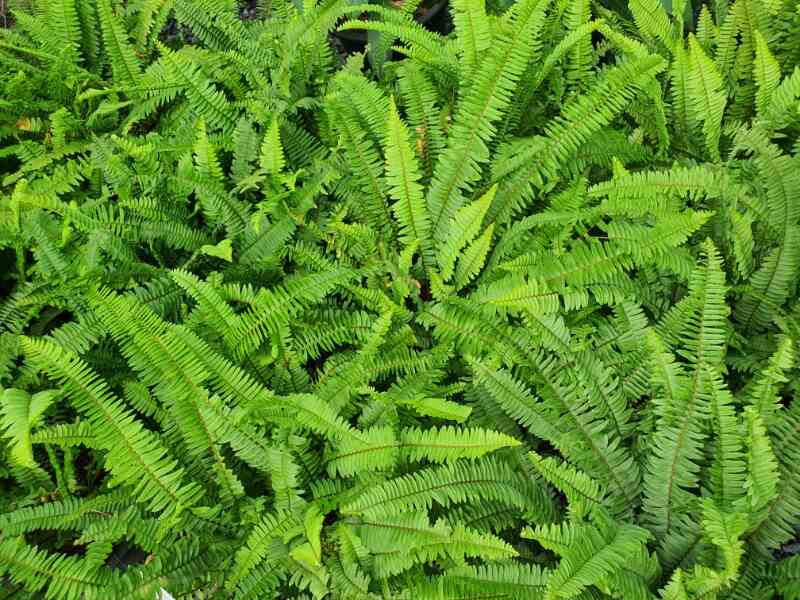
A native spreading fern, kupukupu covers the soil in a sea of feather-shaped leaves. It gives any yard a rich, lush look. The thick growth also makes it an excellent natural tool to banish local weeds from your land.
Kupukupu is one of the most shade-hardy ground covers for tropical gardens. It also grows well in full sun and looks amazing in containers.
- Other common names: Fishbone fern, narrow sword fern, and sword fern.
- Size at maturity: 8 inches to 2 feet tall and 1 to 4 feet wide.
- Light requirements: Full sun, light to medium shade.
- Soil type: It prefers moderately moist, well-drained soils but can tolerate some drought.
- Tolerant of: It has good tolerance to drought and wind.
- Maintenance:
— Remove dead leaves to keep a neat look in your garden.
— Trim if it passes into flower beds or areas dedicated to other plants.
— Water periodically to keep the soil moist but not soaked. Overwatering can damage plants.
13. Red Ivy (Hemigraphis alternata)
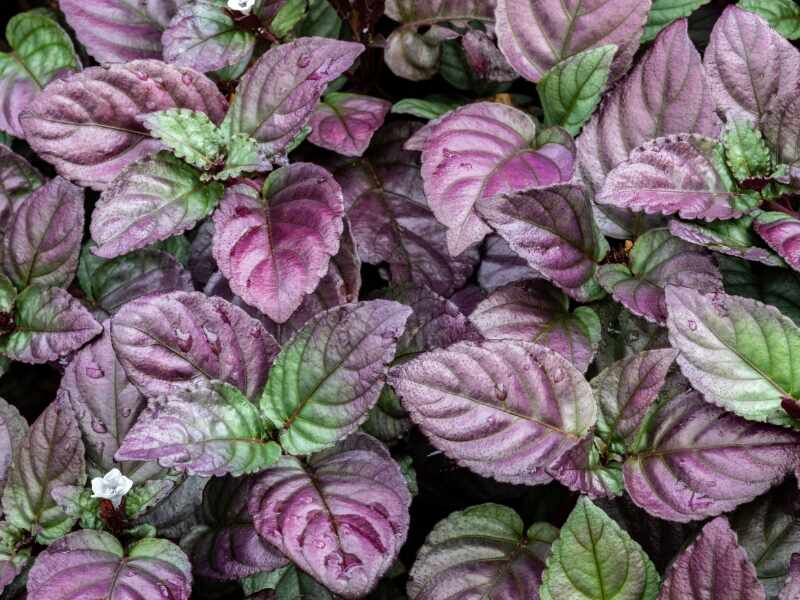
Native to the Maluku Islands of Indonesia, red ivy is an excellent ground cover for shaded areas. You can plant it under trees, shrubs, or in the shadow of tall buildings. Its extensive roots help it thrive on sloped areas, but it’s less suitable for coastal gardens with salty spray.
Red ivy has contrasting colors that add dimension to landscape designs. In deep shade, the upper leaves turn a silvery hue, while the undersides are a deep purple red. It’s also a lovely new plant to add to patios and indoor spaces in containers or hanging baskets.
- Other common names: Metal leaf, metallic plant, red ivy, red-flame ivy, and waffle plant.
- Size at maturity: Up to 6 inches tall.
- Light requirements: It thrives in bright indirect light to medium shade but doesn’t tolerate full shade.
- Soil type: Red ivy prefers slightly acidic to neutral, moist, rich, loamy, well-drained soil.
- Tolerant of: Grows well on slopes but is not salt and drought-tolerant.
- Maintenance:
— Water if the top ¼ inch of soil is dry.
— Prune at the beginning of the growing season.
14. Mondo Grass (Ophiopogon japonicus)
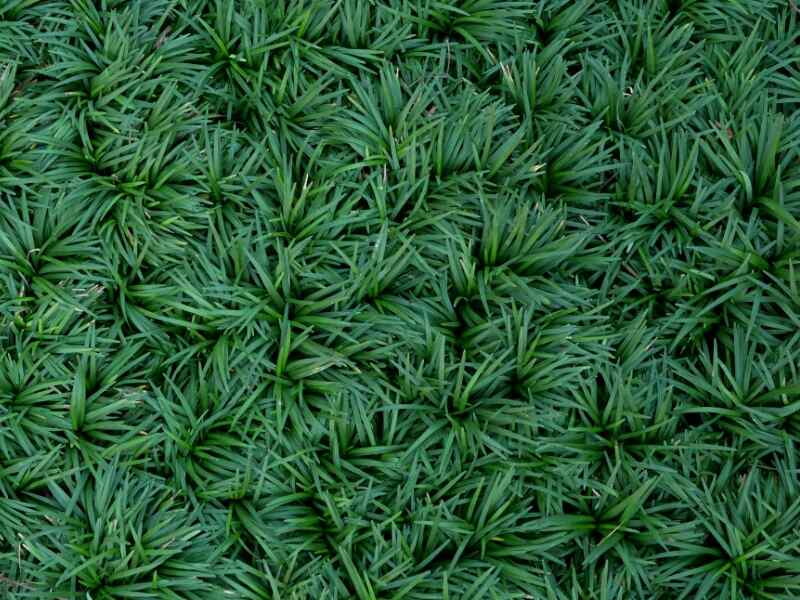
Neither a true grass nor a sedge, Ophiopogon japonicus is a no-mow grass-like ground cover you can use to replace a high-maintenance lawn. It grows in tufts of thin, long dark green leaves that spread rhizomes across the soil. Mondo grass blooms small white or bluish flowers rarely seen in Hawaii.
It grows best with some shade. To cover large areas in your yard, look for fast-growing varieties. For edging walkways, dwarf cultivars are better.
- Other common names: Dwarf lilyturf, snake’s beard, monkey grass.
- Size at maturity: Up to 1 foot tall and wide.
- Light requirements: It grows in full shade to full sun and thrives in partial shade.
- Soil type: It thrives in fertile, moist soil.
- Tolerant of: Mondo grass tolerates wind, mild foot traffic, and moderate drought.
- Maintenance:
— Mondo grass doesn’t require trimming.
— Water more often if planted in full sun.
— Spread ½ inch of compost over the mondo grass for the first few years to help promote lateral spreading of rhizomes.
Pros and Cons of Choosing Ground Covers
Installing ground covers instead of turf is a common method used across the U.S. to simplify lawn care and save water, money, and time. Some people are declared fans of this practice. Others still cherish the uniform, lush appearance of trimmed grass (which you can achieve with the best grass types for Hawaii).
We made a list with the main arguments of both sides to help you decide if ground covers are a good option for you.
Pros of Planting Ground Covers
✓ They add texture and depth to monotonous gardens.
✓ Create more natural landscapes.
✓ Most have beautiful flowers and colors.
✓ Native Hawaiian plants attract and support pollinators and other local wildlife.
✓ Once established, they typically require less maintenance than turfgrass.
✓ Native ground covers use less water and fertilizers.
✓ They are generally more resilient to local diseases, pests, and weeds.
Cons of Using Ground Covers
✗ They take more time to establish than turfgrass.
✗ Most have a low tolerance for foot traffic and can’t withstand outdoor activities without severe damage.
✗ Some imported ground covers can turn into invasive weeds if not managed correctly, such as wedelia, with its daisy-like lavender flowers, and honeysuckle.
✗ They lack the neat look of trimmed turf and often create the appearance of neglected wild space.
How to Choose the Right Ground Cover for Your Hawaii Yard
Ground covers are easier to care for than turfgrass. But when it comes to choosing the right type, it’s the same or even harder because there’s a huge list of options. Here are three essential criteria to help you compare and choose the best ground cover for your tropical lawn.
Size and Growth Habit
As a rule, we consider ground covers as low-growing plants less than 3 feet tall or which you pruned to this height. Look for a plant that keeps close to the ground if you want something similar to grass, or consider something taller to create hedges or depth.
As for the growth habit, you have to choose between three types:
- The shrub type, with one main stem and horizontal branches, such as ilima papa.
- The vine type grows along the ground and develops roots where stem nodes touch the soil. Good examples are pauohiiaka, nanea, and aeae.
- The clumping type grows as tufts and spreads by offshoots and rhizomes – mondo grass, daylilies, and ukiuki are in this category.
Presence of Flowers
Some people want an all-green, all-leaf, no-flowers option for a ground cover to look similar to grass. Others install them especially to add beautiful, colorful blooms to their outdoor space.
This decision depends on your preferences and what suits best the color and texture of your garden. If installing over a large area, it is usually wise to consult a landscape designer before deciding.
Environmental Conditions
Hawaii has a wide variety of soils, different rainfall amounts from one side of the islands to the other, changes in temperatures as you go up, and salt spray on the coasts.
It’s not enough to know a certain ground cover is native to Hawaii or the tropics. To ensure it thrives in your location, check if it fits the environmental conditions in your garden. Analyze the following:
- Soil texture and drainage
- Rainfall amount
- Salt spray exposure
- Wind exposure
- Tolerance to high heat and drought
- Tolerance to shade/full sun
Planting Ground Covers in Hawaii in Five Simple Steps
Installing a healthy, thriving ground cover requires preparation and care. Here are five simple steps to follow for successful planting.
1. Remove the Weeds
Hand-pull or spread herbicide to remove all the weeds in the area you wish to plant the ground cover.
2. Clear the Ground
Rake all dead weeds and roots from the site. Use a rake to level the soil.
3. Spread a Layer of Good-Quality Compost
In many locations across the islands, the topsoil is thin. Spreading about 1 inch of compost over the soil creates a fertile layer for ground cover roots. Use a roller to get a uniform surface.
Where to buy compost:
4. Plant the Ground Cover
Spread the seeds or plant seedlings. Ensure you know how much space to leave between plants. It’s important to allow the right distance for healthy development.
5. Irrigate the Garden
Water the soil daily (if it doesn’t rain) for two or three weeks until the seeds germinate or the shoots set deep enough roots.
You can also hire a landscaping company to plant the ground cover. LawnStarter can connect you with local experts working daily with Hawaii’s soils and native plants.
Ground Cover Maintenance in Hawaii
Once established, tropical ground covers are easy to maintain. Here’s what you need to take care of.
(Note: compare this to the rigorous maintenance required by traditional turfgrass, as seen in our article How to Grow Grass in Hawaii).
Irrigation During Dry Spells
Most Hawaii ground covers are drought-tolerant and rarely need watering. But not all.
Keep an eye on your garden during the dry spells that often hit the leeward side of the islands in the summer. Irrigate when plants show signs of stress.
Use brackish water only if you’re growing a ground cover that tolerates it well. Pauohiiaka, hinahina and aeae are such examples.
Pruning and Trimming
Prune shrubs periodically to maintain the desired shape and size. Trim vines to prevent them from invading flower beds or climbing on trees and fences. Remove dead and dry leaves and stems to keep the yard neat and beautiful.
Keep an Eye on Weeds
Until newly planted ground covers settle in, you’ll need to take care of any weeds that appear. Hand-pull isolated ones and spot-spray with herbicides when necessary.
Where you can buy effective herbicides:
FAQ About Low-Maintenance Ground Covers for Hawaii
Ilima papa, akia, ukiuki, and hinahina are ground covers you can successfully grow in full sun in Hawaii.
Golden glory is a beautiful ground cover you can grow in Hawaii in areas with poor soil. It needs little water and nutrients to thrive.
Pohinahina and ilima papa are two of the most durable tropical ground covers. You can plant them in Hawaii’s coastal areas, inland, and upland gardens. Once established, they will thrive with ease.
Enjoy a Gorgeous Hawaii Garden Today
Ground covers are exotic, rich, interesting alternatives to traditional turfgrass. They are low-maintenance, resilient, and colorful, transforming any yard into an amazing outdoor space.
Contact a local Hawaii landscaping company and plant the best ground cover in your Hawaiian garden. From the dry Honolulu to the humid Hilo, LawnStarter can help you find the best expert for the job.
Main Photo Credit: LUCKOHNEN / Canva Pro / License
LawnStarter participates in the Amazon Services LLC Associates Program, an affiliate advertising program. LawnStarter may earn revenue from products promoted in this article.